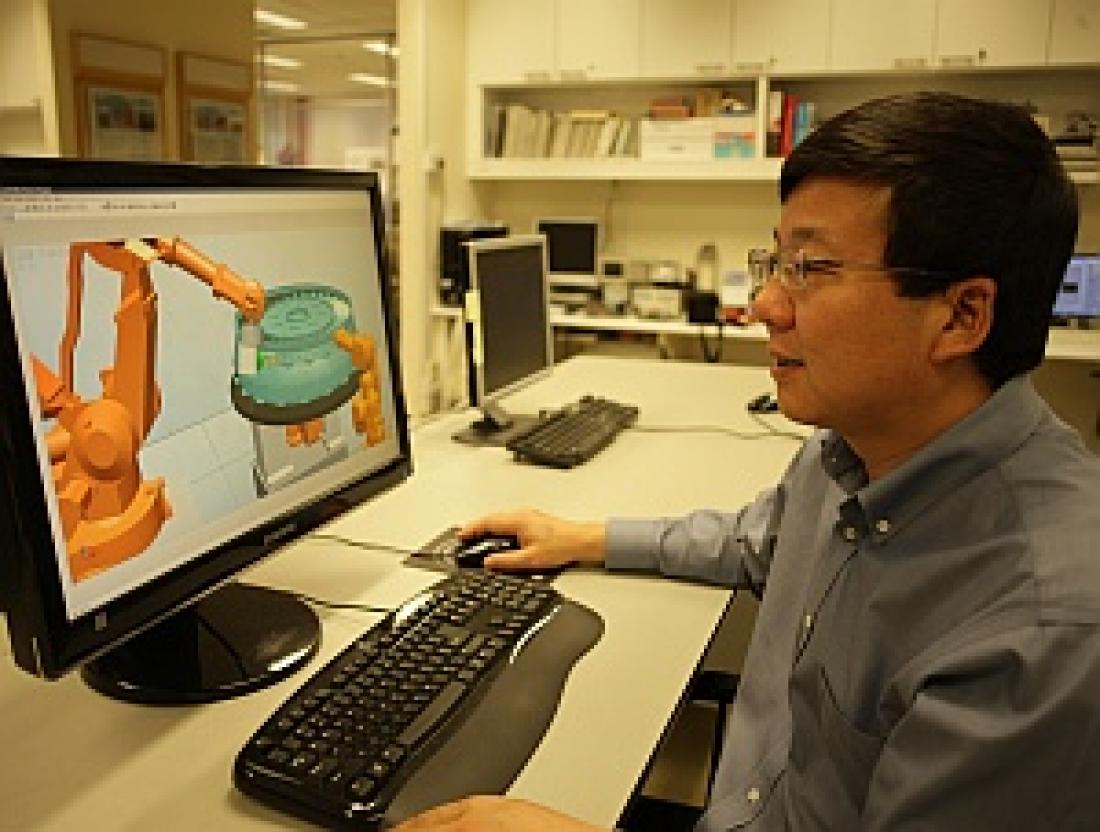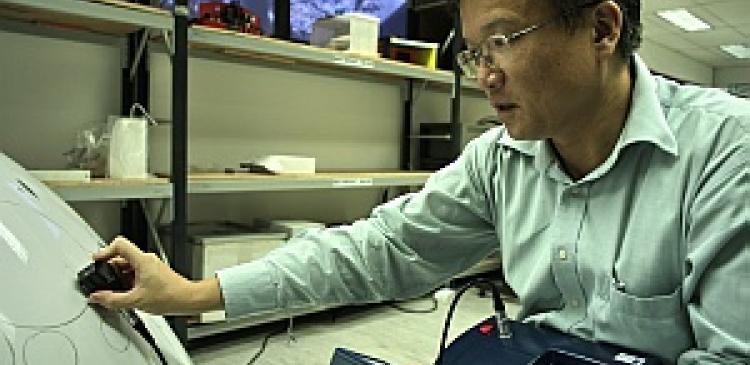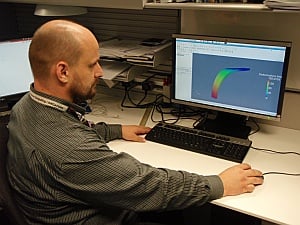Guilin Yang
Global air travel, far from being in decline, continues to expand every year driven by rapidly emerging economies such as China and India. There are predictions that up to 28,200 new passenger jetliners and freighters could be in operation worldwide by 2025, and the aircraft fleet in Asia alone is expected to triple over the same period. Ensuring the safety of this massive fleet of aircraft will become a critical issue as the maintenance, repair and overhaul (MRO) industry expands to meet demand. The development of advanced MRO technologies has therefore never been so important.
Thanks to its geographical location, Singapore is the largest MRO hub in Asia, with a market share of close to 25%. Over 100 international companies are carrying out MRO operations in Singapore for a variety of services from airframe maintenance to avionics systems repair. These companies also benefit from the scientific and engineering expertise offered by researchers at A*STAR and elsewhere in Singapore.
In 2007, A*STAR launched the A*STAR Aerospace Programme to establish a common research platform that will support the competitiveness and growth of local aerospace companies and technology. In February 2008, the first four projects kicked off with a total investment of S$10 million over three years. The A*STAR Aerospace Programme has since funded another 20 projects, and the number of participating companies has expanded from the original four—Boeing, European Aeronautics Defence Systems, Pratt and Whitney and Rolls-Royce—to 18 over the last four years. “We have excellent infrastructure, good support from the government and a strong research foundation,” says Guilin Yang, one of the program’s principal investigators. “We can also offer a very innovative development model and intellectual property protection.” The program has A*STAR researchers working in international teams comprising dozens of scientists and engineers from around the world.
Robots for surface finishing
Yang is group manager of mechatronics at A*STAR’s Singapore Institute of Manufacturing Technology (SIMTech). His team recently completed a project on robotized precision finishing, which involved customizing industrial robots to chamfer edges and remove burrs as part of the process of smoothing the edges of large workpieces such as aero-engine components. In most aerospace factories, skilled workers handle these processes manually for large workpieces. “The manual approach is a very time-consuming process because there are so many small features,” says Yang. “It is also difficult with manual operations to guarantee quality consistency, particularly in the tough working environment of these factories.”
One of the biggest technological challenges they encountered in the development of the robotic finishers was the control of contact force for material removal, which is considered difficult to automate because features on edges are usually complex, Yang explains. “Industrial robots are designed for position and velocity control, not for force control,” he says. As the workpieces needing chamfering and deburring are complex, tool path planning and robot programming are also key technologies for automation.
Yang and his colleagues developed various technologies, including force-control-based material removal techniques, an in situ profile measurement system, robotic workcell calibration methods and tool path planning algorithms based on computer-aided design modeling. These technologies have been successfully implemented to perform the serial process of chamfering and deburring. The team eventually demonstrated the edge profiling of components with finishing accuracy of up to ±0.2 millimeters. Although the project is now complete, Yang says his team will continue improving the performance of the technology and develop further applications.
Non-destructive testing
Wei Lin, senior scientist of mechatronics at SIMTech, has also completed another three-year project, in this case on developing non-destructive tests for composite materials. Ultrasonic technology is widely used for the non-destructive testing of isotropic materials such as metals, but the composite materials used in modern aircraft pose a challenge for this conventional method. The typical composites used, such as carbon fiber-reinforced plastics with different materials types and configurations, have a sandwich structure of laminate skins and an internal honeycomb-like structure, which tend to develop very peculiar flaws. “Eventually we want to see how these defects affect the mechanical strength of the materials. A defect may still be okay to fly, but ultimately aircraft carriers want to know when they fail,” says Lin.
Lin’s team has developed a sonic technique that is performed at a frequency lower than that of conventional ultrasonic techniques. Unlike the time-of-flight parameter used in traditional techniques for flaw detection, Lin’s team excites the material to be inspected with certain waveform patterns and processes the excitation response in several ways to extract defect signatures. “As a result, very fine differences among flaws, such as disbonds, delaminations and even kissing bonds, can be detected and identified,” says Lin. Moreover, he adds that the inspection area can be easily scanned manually, and the results can be displayed in a map format.
As a follow-up project under the A*STAR Aerospace Programme, Lin’s team is currently working to improve the technique for inspecting composite materials with incipient heat damage.
Computer simulations
Tomas Karasek, a scientist at the A*STAR Institute of High Performance Computing, is working on two new simulation projects that could support advanced MRO operations in the future. One of the simulations aims to optimize composite structures subject to impact loads of a few milliseconds in duration. This type of impact is tested by dropping a test beam from a certain height. “Current structural designs tend to be easily damaged by impacts. Our objective is to optimize composite materials, in term of the number of layers, the material’s constituents and even the orientation of individual layers, so that the test beam can survive the drop without damage,” he explains.
The other project being pursued by Karasek’s team is the development of a faster and more cost-effective method for numerically simulating the optimal coverage for the metal shot peening process—a cold finishing step in which small metallic balls are shot into a surface to increase durability. The conventional optimization process relies on visual appraisal by an experienced technician. Karasek’s team is aiming to introduce a more objective approach by creating a tool to predict the optimal coverage given important shot-peening parameters such as peening pressure, intensity and time for various components and geometries. Simulations have been attempted before, but by taking a different approach Karasek hopes to shorten the computational time required for the simulation significantly.
Rapid expansion
Karasek’s twin projects are among the eight new projects launched in February 2011. The number of projects started each year under the SERC Aerospace Programme is on the rise, which has added impetus to the search for collaborative development with private companies and research institutes. Other cutting-edge technologies under development include intelligent fiber Bragg grating sensors for aircraft structural health monitoring and diagnosis, organic nanoparticles for erosion-resistant aircraft coatings, and low-cost, real-time monitoring for early corrosion detection using millimeter-wave technology. “The aerospace industry is rolling out cutting-edge technology and high-tech products with high added value. There is a lot of room for research,” says Karasek.
About the A*STAR Aerospace Programme
The A*STAR Aerospace Programme was launched in January 2007 to facilitate research and development with the aerospace industry. This effort, spearheaded by the A*STAR Science and Engineering Research Council (SERC), allows aerospace companies to leverage A*STAR’s vast resources to carry out industry-directed research and technology development, and addresses the needs of many aerospace companies wishing to form strategic partnerships on development to reduce investment risk and optimize business opportunities.
Computer simulations
Non-destructive testing





